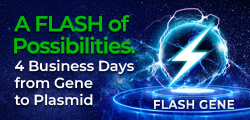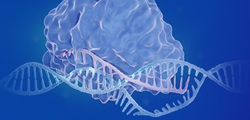-
REAGENT SERVICES
Hot!
-
Most Popular Services
-
Molecular Biology
-
Recombinant Antibody/Protein
-
Reagent Antibody
-
CRISPR Gene Editing
-
DNA Mutant Library
-
IVT RNA and LNP Formulations
-
Oligo Synthesis
-
Peptides
-
Cell Engineering
-
- Gene Synthesis FLASH Gene
- GenBrick™ Up to 200kb
- Gene Fragments Up to 3kb now
- Plasmid DNA Preparation Upgraded
- Cloning and Subcloning
- ORF cDNA Clones
- mRNA Plasmid Solutions New!
- Cell free mRNA Template New!
- AAV Plasmid Solutions New!
- Mutagenesis
- GenCircle™ Double-Stranded DNA New!
- GenSmart™ Online Tools
-
-
PRODUCTS
-
Most Popular Reagents
-
 Instruments
Instruments
-
Antibodies
-
ELISA Kits
-
Protein Electrophoresis and Blotting
-
Protein and Antibody Purification
-
Recombinant Proteins
-
Molecular Biology
-
Stable Cell Lines
-
Cell Isolation and Activation
-
 IVD Raw Materials
IVD Raw Materials
-
 Therapy Applications
Therapy Applications
-
Resources
-
- All Instruments
- Automated Protein and Antibody Purification SystemNew!
- Automated Plasmid MaxiprepHot!
- Automated Plasmid/Protein/Antibody Mini-scale Purification
- eBlot™ Protein Transfer System
- eStain™ Protein Staining System
- eZwest™ Lite Automated Western Blotting Device
- CytoSinct™ 1000 Cell Isolation Instrument
-
- Pharmacokinetics and Immunogenicity ELISA Kits
- Viral Titration QC ELISA Kits
- -- Lentivirus Titer p24 ELISA KitHot!
- -- MuLV Titer p30 ELISA KitNew!
- -- AAV2 and AAVX Titer Capsid ELISA Kits
- Residual Detection ELISA Kits
- -- T7 RNA Polymerase ELISA KitNew!
- -- BSA ELISA Kit, 2G
- -- Cas9 ELISA KitHot!
- -- Protein A ELISA KitHot!
- -- His tagged protein detection & purification
- dsRNA ELISA Kit
- Endonuclease ELISA Kit
- COVID-19 Detection cPass™ Technology Kits
-
- Automated Maxi-Plasmid PurificationHot!
- Automated Mini-Plasmid PurificationNew!
- PCR Reagents
- S.marcescens Nuclease Benz-Neburase™
- DNA Assembly GenBuilder™
- Cas9 / Cas12a / Cas13a Nucleases
- Base and Prime Editing Nucleases
- GMP Cas9 Nucleases
- CRISPR sgRNA Synthesis
- HDR Knock-in Template
- CRISPR Gene Editing Kits and Antibodies
-
![AmMag™ Quatro Automated Plasmid Purification]() AmMag™ Quatro automated plasmid purification
AmMag™ Quatro automated plasmid purification
-
![Anti-Camelid VHH]() MonoRab™ Anti-VHH Antibodies
MonoRab™ Anti-VHH Antibodies
-
![ELISA Kits]() ELISA Kits
ELISA Kits
-
![Precast Gels]() SurePAGE™ Precast Gels
SurePAGE™ Precast Gels
-
![Quatro ProAb Automated Protein and Antibody Purification System]() AmMag™ Quatro ProAb Automated Protein and Antibody Purification System
AmMag™ Quatro ProAb Automated Protein and Antibody Purification System
-
![Target Proteins]() Target Proteins
Target Proteins
-
![AmMag™ Quatro Automated Plasmid Purification]() AmMag™ Quatro automated plasmid purification
AmMag™ Quatro automated plasmid purification
-
![Stable Cell Lines]() Stable Cell Lines
Stable Cell Lines
-
![Cell Isolation and Activation]() Cell Isolation and Activation
Cell Isolation and Activation
-
 IVD Raw Materials
IVD Raw Materials
-
![Quick
Order]() Quick Order
Quick Order
-
![Quick
Order]() Quick Order
Quick Order
- APPLICATIONS
- RESOURCES
- ABOUT US
- SIGN IN My Account SIGN OUT
- REGISTER

![Amino Acid Code Amino Acid Code]()
DNA Related Biological Terms
This Biology terms dictionary provides query services for biology and biochemistry terms. Please enter the biology or biochemistry terms you want to search.
List by Alphabet: A B C D E F G H I J K L M N O P Q R S T U V W X Y Z
DNA Related Biological Terms:
DNA for which a function has yet to be identified. An elaborate nomenclature has been proposed for this DNA: any stretch of DNA is a nuon; DNA with an evolutionary potential for development of function is a potonuon; DNA that was previously non-functional, or that had a completely different function and has been evolutionarily co-opted for a new function (a process termed exaptation), is a xaptonuon; and a non-co-opted potonuon is a naptonuon.Brosius, J. and Gould, S.J. (1992) Proc. Natl. Acad. Sci. U.S.A. 89, 10706-10710; Nowak, R. (1994) Science 263, 608-610; Flam, F.F. (1994) Science 266, 1320
(= multiple-copy single-strand DNA (msDNA))
Mitochondrial DNA; a double-stranded polynucleotide composed of a heavy and a light chain, distinguished by the buoyant densities of the separated strands, which are determined by their G+T content.
A satellite DNA detected in some bacteria that features an oligoribonucleotide attached by the 2'-hydroxy group of an inteRNAl guanylate residue to the 5'-end of an oligodeoxyribonucleotide, while the 3'-end of the DNA moiety is base-paired with the 5'-end of the RNA moiety; both the DNA and RNA possess considerable inteRNAl base-pairing. Inouye, M. and Inouye, S. (1991) Trends Biochem. Sci. 16, 18-21
A satellite DNA detected in some bacteria that features an oligoribonucleotide attached by the 2'-hydroxy group of an inteRNAl guanylate residue to the 5'-end of an oligodeoxyribonucleotide, while the 3'-end of the DNA moiety is base-paired with the 5'-end of the RNA moiety; both the DNA and RNA possess considerable inteRNAl base-pairing. Inouye, M. and Inouye, S. (1991) Trends Biochem. Sci. 16, 18-21
A library that includes all cDNA clones at approximately equal frequencies, unlike most cDNA libraries, which represent cDNAs in rough proportion to the occurrence of their mRNA in the source.Bonaldo, M.F., Lennon, G. and Soares, M.B. (1996) genome Res. 6, 791-806
A souble-stranded form of the nucleic acid which differs from B-, A- and Z-DNA in being less tightly coiled and more extended and having the phosphate backbone on the outside.Allemand, J.F., Bensimon, D., Lavery, R. and Croquette, V. (1998) Proc. Natl. Acad. Sci. USA 95, 14152-14152
A form of DNA in which four oligo(G) sequences, either of the same or of different strands, LINE up either in a parallel, an anti-parallel or in a fold-back (mixed parallel and antiparallel) pattern. The interior of quadruple the helix has four guanine bases in Hoogstein base pairings; each plane of four guanines is separated from the adjacent plane by a Na+ or K+ ion. Although these structures have not been identified cells, they are strongly suspected to cap the ends of chromosomal DNA. see telomerePalecek, E. (1991) Crit. Rev. Biochem. Mol. Biol. 26, 151-226; Yagil, G. (1991) Crit. Rev. Biochem. Mol. Biol. 26, 475-559; Borman, S. (1998) Chem. Eng. News 76 (40) 42-46
Recombinant DNA.
A method to produce improved strains, e.g. salt tolerance of a plant, by gene amplification. random genome fragments are introduced into a vector and grown in a bacterium. The plasmid is then introduced into the original strain at the DNA sequence homologous with the DNA fragment, under conditions that favor tandem repeats. Modified strains are selected first by a resistance marker that was part of the original plasmid, then by cycles of selection under pressure of the desired property, e.g. at high salinity.Mavingui, P., Flores, M., Romero, D., Martinez-Romero, E. and Palacios, R. (1997) Nat. Biotechnol. 15, 564-569
-
Top Search
-
Hot Glossary
-
Molecular Biology
If you know of any terms that have been omitted from this glossary that you feel would be useful to include, please send detail to the Editorial Office at GenScript: website@genscript.com
If your term is adopted, we will send 1,000 EzCoupon points to your GenScript account.
-




































